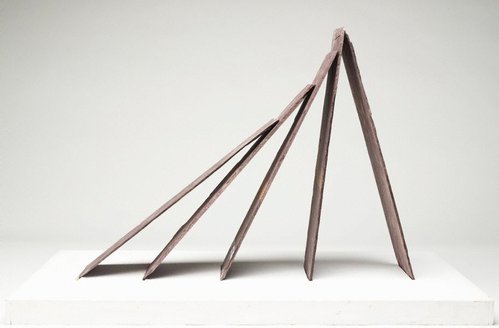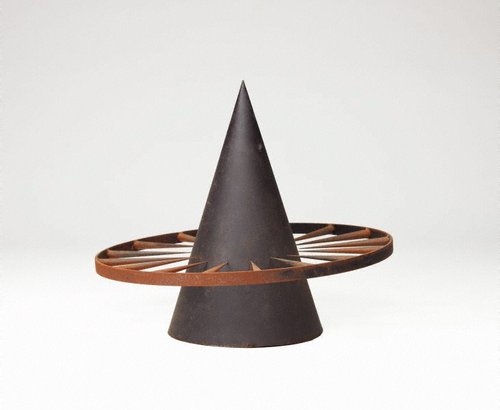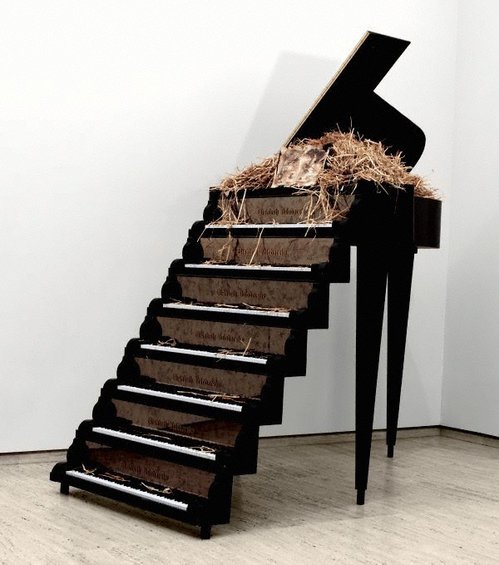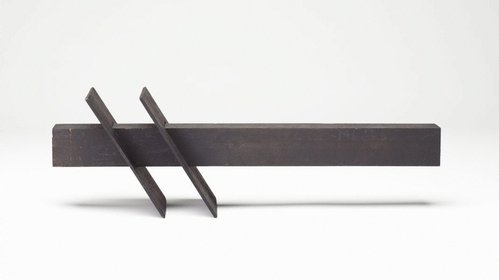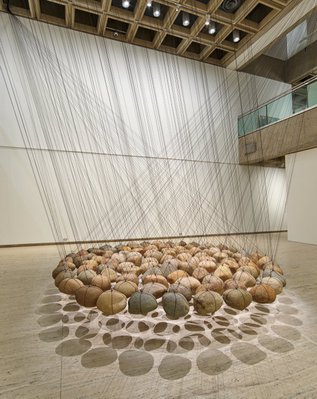
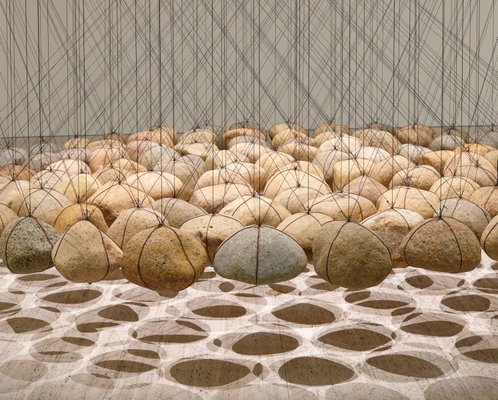
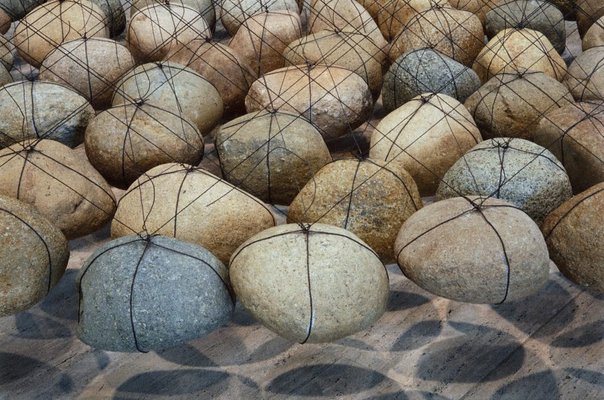


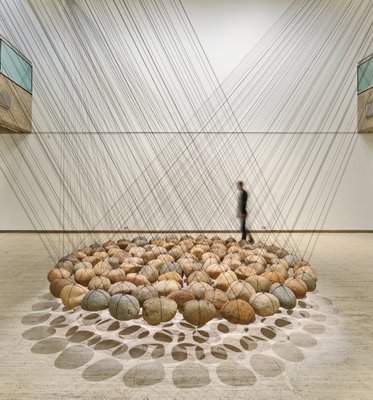
-
Details
- Dates
- 1974-1977
1988 - Media categories
- Sculpture , Installation
- Materials used
- 103 river stones, wire
- Dimensions
- 400.00 cm diam. overall
- Signature & date
Not signed. Not dated.
- Credit
- Purchased 1988
- Location
- South Building, lower level 1, 20th-century galleries
- Accession number
- 356.1988.a-yyyy
- Copyright
- © Ken Unsworth
- Artist information
-
Ken Unsworth
Works in the collection
- Share
-
-
About
Ken Unsworth came to prominence as a sculptor in the 1970s, when he combined performance or body art with highly conceptual sculptural forms. Some of these performances, in particular 'Five secular settings for sculpture as ritual', involved using his own body as a kind of minimalist sculpture. In one, he posed spread-eagle on the wall, held aloft by a pole between his shoulder blades in a visual recreation of Richard Serra's lead prop piece now held in the National Gallery of Australia collection in Canberra.
Unsworth's art is often ephemeral, surviving only in the memory of those who once saw it or in rumours of that memory, or sometimes as photographs or scratchy old videos. Like Joseph Beuys, whose work Unsworth passionately admires, his art is full of apparent contradictions. He reworks the great sagas of life and death while shaking the staff of a jester and yet he has created remarkable and enduring monumental sculptures. He is admired by formalists for his sculpture and for the rigorous logic of propped or suspended stones, while others respond to the expressionism of the paintings and the symbolist theatricality of his kinetic installations.
In many of his early body art pieces, Unsworth held his body in suspension as if levitating between consciousness and unconsciousness, between the material world and the immaterial. The figure seems trapped, pinioned or bound. These works are not only about equilibrium, balance and formal relations; they are also violent and claustrophobic experiences and many of his sculptures continue this theme. 'Suspended stone circle II' is one of his levitation works with 103 river stones each weighing around 15 kilograms held in place by three wires tied to three rings secured to the ceiling structure. The stones form a suspended disc, with each one held as if in a force field. The stones are hung so that their centre of gravity falls exactly on the central axis of the disc and each stone is equidistant from its neighbours. The three sets of wires create three cones, suggesting the force field which they literally constitute.
'Rapture' 1994 (AGNSW collection) also obliquely relates to levitation in that it implies a stairway to heaven and thus suggests the dream of transcending the material world. The grand piano that forms the stairway may be thought of as having the potential to bring us to a transcendent moment by the beauty of its music but alas it is stuffed full of straw with mice running through it. This piano is never going to enchant with its sound again.
The popularity of Unsworth's sculptures with a wider audience may be attributed to the richness of aesthetic effects and to the experience of witnessing a psychodrama unfolding. Beauty and delirium fade into melancholia and back into laughter. Unsworth is able to make you cry and laugh at the same time. He has lived and suffered as much as most of us so that his art is able to reflect our own deepest fears, joys and secrets. Art seldom delivers magic any more but Unsworth nearly always does. And just as it was with Beuys, Ken Unsworth’s laughter is infectious.
© Art Gallery of New South Wales Contemporary Collection Handbook, 2006
On recreating the work at the AGNSW in 2022, Unsworth offered this reflection on his much-loved work:
'River stones found on fallow earth studded with dead grasses or dried up river beds, lie inert, obdurate and sullen under the constant tyranny of their mass. Rendered into another context, freed from their bondage, they reveal in many forms and guises their inner voice – perhaps a chorus of stones singing their own songs.
'As a formal sculptural installation it works as a rational precise structure. The aesthetic of its geometry is indicative, and at the same time perceptually puzzling. A constellation levitating above the ground, meditating on things past and yet to come, stirring hidden memories of some ancient sacrificial altar.'
-
Exhibition history
Shown in 2 exhibitions
Ken Unsworth, Art Gallery of New South Wales, Sydney, 02 Oct 1998–15 Nov 1998
20th-Century galleries, lower level 1 (rehang), Art Gallery of New South Wales, Sydney, 20 Aug 2022–2023
-
Bibliography
Referenced in 12 publications
-
George Alexander, Look, 'Who's afraid of Contemporary art?', pg. 9, Heidelberg, Aug 1998, 9 (colour illus.).
-
Anthony Bond, Contemporary: Art Gallery of New South Wales Contemporary Collection, 'Objects and associations', pg.332-381, Sydney, 2006, 378, 379 (colour illus.).
-
Anthony Bond and Victoria Lynn, AGNSW Collections, 'Contemporary Practice - Here, There, Everywhere ...', pg. 229-285, Sydney, 1994, 243 (colour illus.).
-
Tony Bond, Look, 'Ken Unsworth: magician, jester, enigma', pg. 14-15, Heidelberg, Oct 1998, 14 (colour illus.).
-
Edmund Capon AM, OBE, Art Gallery of New South Wales: highlights from the collection, Sydney, 2008, 135 (colour illus.).
-
Benjamin Genocchio, Art and Australia (Vol. 39, No. 1), 'Australian art in the Art Gallery of New South Wales', pg. 167-168, Sydney, Sep 2001-Nov 2001, 167 (illus.).
-
Marianne Hulsbosch (Editor), Cambridge visual arts: stage 4, Cambridge, 2008, 177 (colour illus.).
-
Bruce James, Art Gallery of New South Wales handbook, 'Australian Collection: Painting and Sculpture', pg. 102-181, Sydney, 1999, 175 (colour illus.).
-
Barry Pearce, Australian art: in the Art Gallery of New South Wales, 'The enduring image', pg. 165-166, Sydney, 2000, 282 (colour illus.), 302.
-
Bernard Rigby, Look, 'Science in the stones', Melbourne, Nov 2001, 19 (colour illus.). full illustration plus detail
-
John Saxby, Look, 'Rock star: Ken Unsworth', pg. 42-47, Sydney, Oct 2022-Nov 2022, 46, 47 (colour illus.).
-
Kate van den Boogert (Editor), Ken Unsworth, Melbourne, 1998, 49 (illus.), 93. cat.no. 28
-

